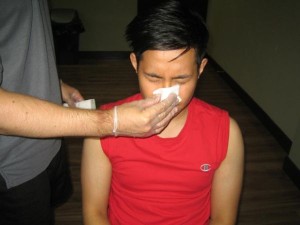A nosebleed or epistaxis is often a cause of worry for parents and babysitters.

However, nosebleeds are actually common among children and rarely a true medical problem. They most commonly occur as a result of injury to the soft tissues of the nasal cavity. Other possible causes of nosebleeds include dry air, repeated nose-blowing or nose-picking, and some allergies.
Disclaimer: the information posted on this page for first aid tips for nosebleeds is for learning purposes only. To learn to recognize and treat nosebleeds and other minor bleeding issues sign up for first aid training with a workplace approved provider near you.
Nosebleed first aid procedures
Regardless of the cause of the bleeding, first aid treatments are often the same.
- Stay calm and provide reassurance.
- Have the child sit upright and slightly leaning forward. Sitting upright reduces the blood pressure in the blood vessels of the nose, preventing further bleeding. Leaning forward prevents ingestion of the blood, which can further irritate the stomach.
- Using your thumb and index finger, gently pinch the nose bridge. Make sure the nasal passages or nostrils are shut. Breathe through your mouth. This should be done for 5-10 minutes or until bleeding has stopped. Applying pressure to the bleeding vessels can help stop bleeding.
- Instruct the child to avoid blowing or picking the nose. Also avoid bending down for several hours after the nosebleed. The head should always be kept higher than the heart level several hours following episode of bleeding.
- If re-bleeding occurs, clear the nose for possible blood clots by blowing out forcefully and spraying the insides of the nose with a decongestant nasal spray. Then, follow the same procedures described above.
When to seek professional help
Although nosebleeds are rarely serious, there are some cases that require further medical attention.
If there is repeated bleeding or bleeding that lasts for more than 20 minutes, call your healthcare provider immediately. Repeated nosebleeds might indicate an underlying condition. For example, some children who have allergies most commonly get frequent nosebleeds because the blood vessels in the nasal cavity become irritated so often and fail to heal properly.
Cases of recurrent nosebleeds can be easily treated with either medical or surgical procedure. There are different medications (usually in spray form) that may be prescribed to control nosebleeds. Your doctor may recommend cauterizing the blood vessels. Cautery is a procedure wherein electric current, laser or silver nitrate is used to burn the bleeding vessel. After the procedure, the doctor packs the nose with gauze or an inflatable latex balloon to put pressure on the bleeding vessel.
If the cause of bleeding is unknown, the doctor may recommend other tests to rule out more serious conditions, especially involving the brain or spinal cord and bleeding problems.
You should also seek medical assistance if the nosebleed is caused by an injury to the head, fall, or an accident. Children who are taking blood thinners and experience nosebleed should also see a doctor.
